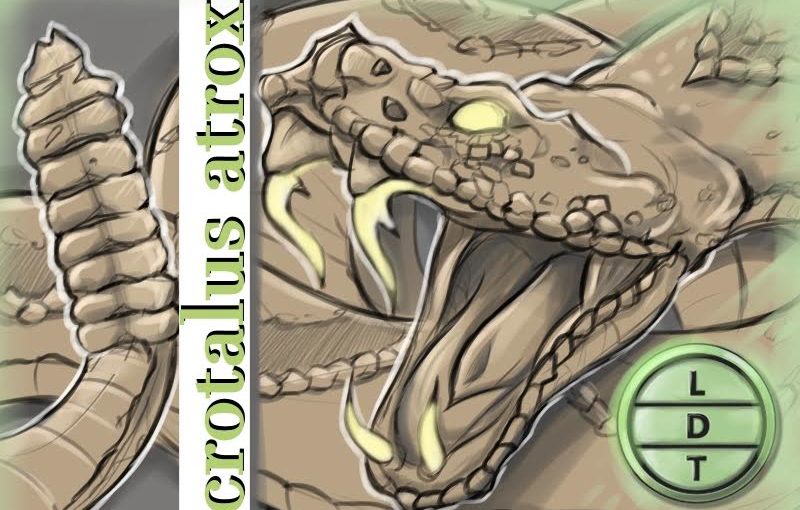“And today we’re talking about a moody snek with a bejeweled back and baby toy for a butt!”
Sometimes, all you need in a shootout is a keen eye and your trusty gun. But nature’s tricky, and you can’t always see your target with just your eyes. The Western Diamondback Rattlesnake can see through the fog, dust, and darkness that covers this here frontier, and it’s mighty glad it can. From stem to stern, this veritable killin’ machine is built for catchin’ varmints of all shapes and sizes, which makes it the perfect specimen of the wild west where the law is Life, Death, and Taxonomy.
Music: The Good, The Bad, and the Ugly by Ennio Morricone
Artwork: xnamaru
Description
- The Western Diamondback Rattlesnake is a brown snake of modest girth and long scaley body.
- It’s head is thicker than it’s neck and has that typical bulbus viper shape.
- It has a black, brown, and off white diamonds on its back that give it it’s name
- It’s tail comes to a signature rattle that is typically cream colored or yellow.
Measure Up
Length – 120 cm (4ft) – How many rattlesnakes go into the depth of Chase Field, home of the Arizona Diamondbacks, from home plate to center field? (407 ft or 124 m)? Hint: The deepest outfield in the MLB is Comerica Park in Detroit. Answer: 101.7 snakes
Weight – 1.23 to 2.7 kg (3 to 6 lb) – 4.5 pounds on average – How many Cullinan Diamonds (3,106.75 carats or 621.35 g), the largest diamond ever found, go into the average diamondback rattlesnake? Hint: The diamond was found in the Cullinan mine in South Africa in 1905 and put on sale in London where no one wanted to buy it for two years. Then it was bought by the then British-ruled Transvaal Colony and presented to King Edward 7th on his birthday. The rough stone produced nine cut diamonds, the largest of which is 530.4 carats, and it’s in the head of the Sovereign’s Sceptre with a Cross, which is a piece in the crown jewels. Answer: A little more than three Cullinan diamonds.
Where is it?
- It lives in arid regions of the U.S. and Mexico.
- From Arkansas to California and as far South as Hidalgo
- It enjoys grasslands, plains, rocky terrain, desserts, scrub, and pine-oak forests
- If your driving on a rural road at 7pm in the southwest, watch out! They seem to like asphalt roads and stretch out on them in the early evening to collect some of the heat the blacktop accumulates throughout the day.
Fast Facts
- DB is a solitary animal and definitely identifies as an introvert.
- Throughout the fall and winter, it seeks out nice quiet days, curling up on a sun-soaked rock with a nice book. Except the book part.
- If it gets cold enough, DB will Brumate, which is a type of hibernation that reptiles like.
- During brumation, the snake will spend most of its time sleeping
- Only getting up for a glass of water.
- Snakes may eat more in preparation for brumation.
- Rattle snakes are poor climbers and prefer to keep their bellies firmly planted on the ground.
- They like to eat vloes, rats, prairie dogs, mice, rabbits, squirrels, moles, lizards, birds, and large insects.
- They may get eaten by birds of prey, roadrunners, hogs, and other snakes.
- DB is very aggressive when threatened, even compared to other rattlesnakes.
- It’s more likely to stand its ground than flee.
- It will first shake it’s rattle to warn aggressors.
- If the tail fails, they will strike.
Outro
Merry Christmas every one! We may have just been talking about heat vision and slithery serpents, but we don’t want that to detract from this wonderful time of giving. In fact, this episode is our Christmas gift to you! What’s that, you want to get us a gift, but don’t know what to get us? Well, I’m glad you asked. What we want most for Christmas is, you guessed it, quality time with our families remembering the birth of Jesus. Second on the list would probably be a Red Ryder BB Gun. Then after that, we would love it if you would get together with your friends and family, snuggle up close by the fire, and whisper interesting animal info in their ears. When they inevitably ask you how they can learn such tidbits, tell them that we sent you, and tell them that we said Merry Christmas. Also tell them that their ugly Christmas sweater is actually quite nice. See you next week!

